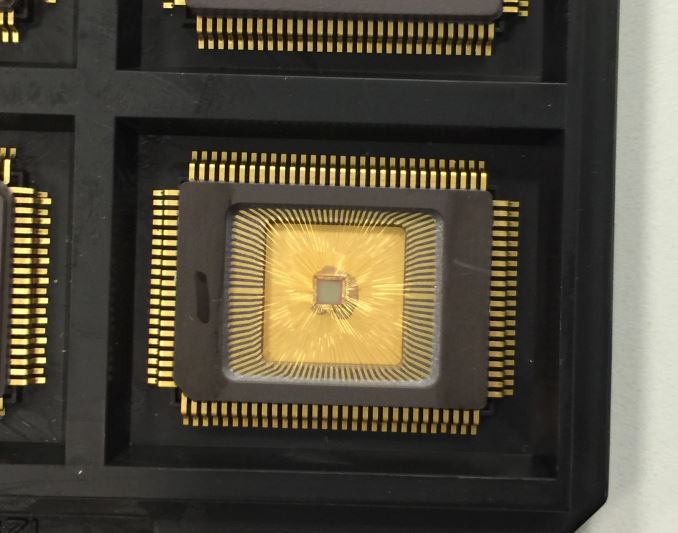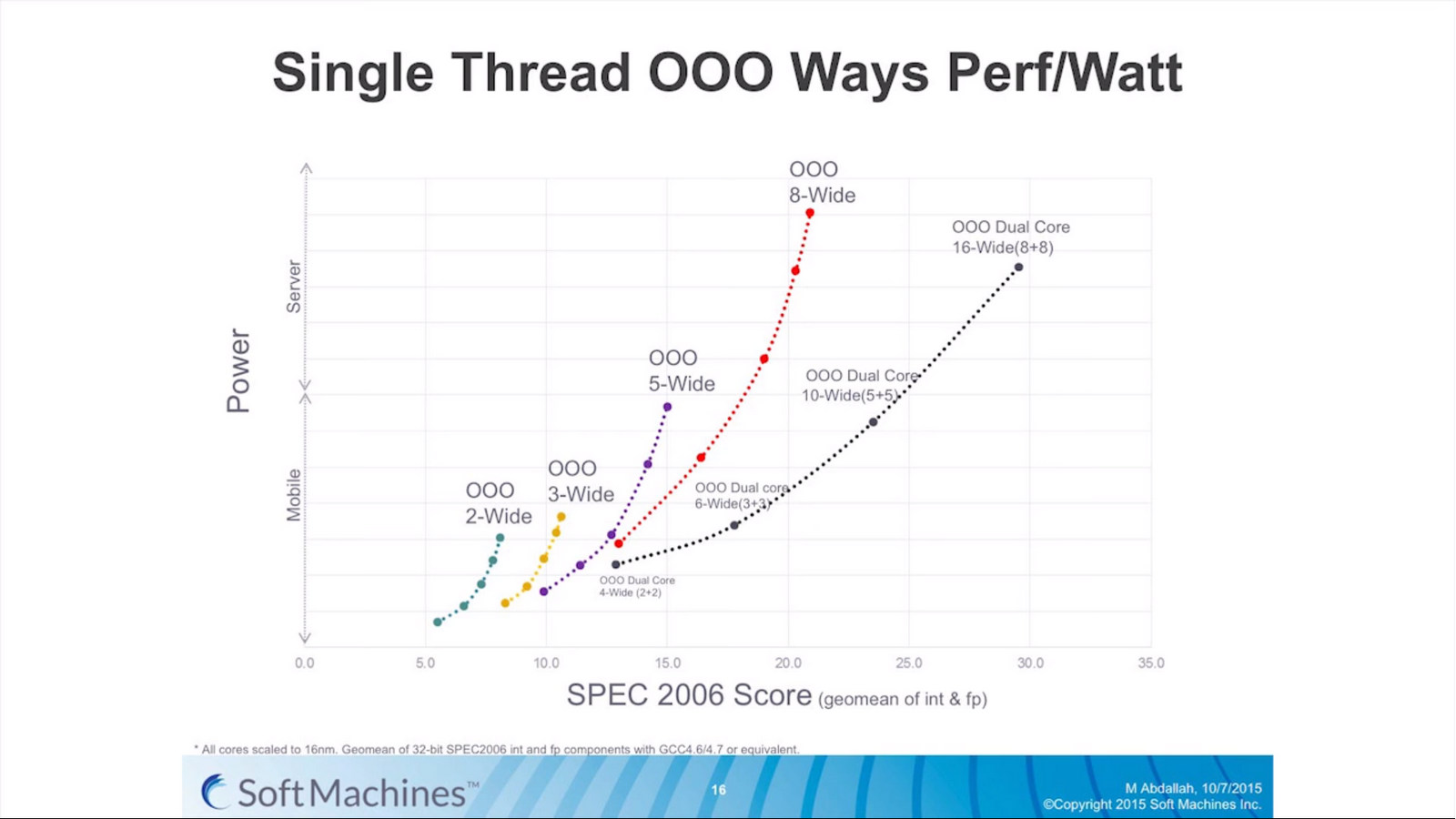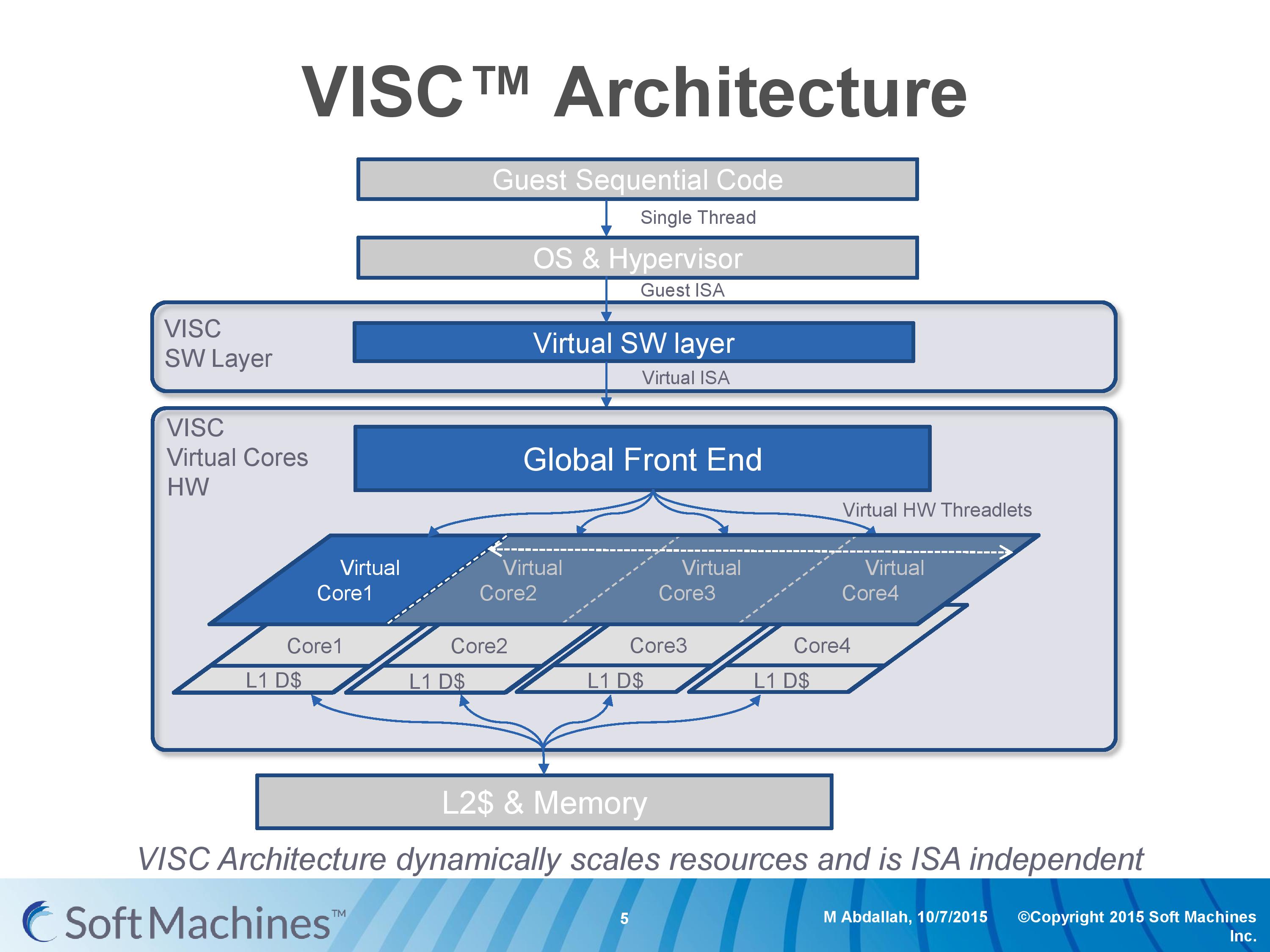Examining Soft Machines' Architecture: An Element of VISC to Improving IPC
by Ian Cutress on February 12, 2016 8:00 AM EST- Posted in
- CPUs
- Arm
- x86
- Architecture
- Soft Machines
- IPC

Last week, Soft Machines announced that their 'VISC' architecture was available for licensing, following the announcement of the original concepts over a year ago. VISC, in a nutshell, is designed as a solution to improving the number of instructions per clock a single thread can process in a given time, which potentially makes it a very interesting design in an era where IPC gains are harder and harder to realize.
The concepts behind their new ‘VISC’ architecture, which splits the workload of a single linear thread across multiple cores, are intriguing and exciting. But as with any new fundamental change in computer processing, subject to a large barrage of questions. We were invited to a presentation and call with the President and Chief Technical Officer Mohammed Abdallah and the VP Marketing and Business Mark Casey, and I put a number of questions on the lips of analysts to them.
Identifying Single Thread Performance Bottlenecks
Any discussion about processor performance over the last couple of decades has involved several factors, including getting better performance through an increased power budget, a higher frequency, extracting instruction level parallelism (ILP), getting better at minimizing delays through better branch prediction, or adding more cores and improving thread level parallelism (TLP). Each of these methods have varying degrees of success at increasing performance – long-time readers will remember the Pentium 4 days of hitting a frequency and power wall which then switched the focus to efficiency. Some tasks, like graphics, are inherently parallel and can take advantage of multiple hundreds or thousands of cores, or the software can be optimized. However, the nature of most software code and instructions is that they are single threaded by nature, and their performance relies on how fast the instructions can be processed within a single thread.
The main way of increasing performance, or in this case the instructions per unit frequency (instructions per clock, or IPC), is to expand the CPU architecture to allow more commands to be processed at once. Moving from a 3-wide out-of-order architecture to a 5-wide out-of-order architecture theoretically allows for a 66% increase in instruction throughput if (and only if) the code is sufficiently dense enough to extract those operations, and the other features in the architecture can ensure all the operations are fed every clock cycle.
The problem with moving to a wider architecture is typically power and design complexity. As shown by various chip designs over the years, the wider the architecture the more silicon has to be set aside for assets like buffers, re-order windows and caching. If there is a silicon budget and enough power headroom, we see designs like the six-wide Intel Skylake cores or the seven wide NVIDIA Denver cores able to extract peak performance when code is written that matches the hardware. However the potential downside of a wide architecture is that it remains inefficient for sets of instructions that only need a 2-wide or a 3-wide architecture. Alternatively, if multiple programs or threads want to use the hardware, then a single core is inaccessible to additional threads while the first thread is still in use (though this can be avoided somewhat by simultaneous multithreading or SMT which will let another thread have access when the first has encountered a stall such as waiting for L1/L2 memory).
As a result, modern designs also include a number of cores to handle the multile thread/multiple program scenario. Generally speaking this works well, especially with high-performance cores, but it becomes a bit of an issue itself when much of the world’s hardware is actually composed of many cores that have poor single threaded performance. Older Core 2 / Conroe systems, basic Bulldozer, or ARM Cortex-A7 designs are (still) widely used and often ship with multiple cores to allow for multiple programs at once. And while they can scale up with additional threads to the number of cores they offer, if any single or lightly-threaded software needs more performance, those extra cores are not used or are only minimally beneficial overall.
This brings us to Soft Machines, whose VISC architecture aims to change this.
Meet VISC
I should start by saying that despite the similarities to other architectural names, VISC is not an acronym. I asked directly and it is merely a noun for the purposes of trademarking. People can interpret it as a ‘virtual instruction set computing’ or something similar, but the company doesn’t apply any acronym to the letters.
But a virtual instruction set is a good description here. For the most part, processor architectures were traditionally built around either CISC (complex) or RISC (reduced) instruction sets and execution models, while more modern designs (e.g. Intel Core) are increasingly a mix, or so-called ‘CRISC’ design. The difference between CISC and RISC boils down to the fact that simpler designs can be more power efficient, but complex designs can do more complicated things in fewer cycles, all the while CRISC essentially meets the two paradigms in the middle in an attempt to gain the benefits of both, though not without inheriting some of the drawbacks as well. VISC, for lack of a better description, is a RISC design using a custom instruction set over a translation layer which allows a single thread of operations to be dispatched over multiple physical cores. The base diagram looks something like this:
Here is an example of a VISC design with four physical cores. The design can handle four ‘virtual cores’ or threads as well, but what makes the VISC design different is that when the virtual core has a thread of instructions, it can use the resources of any physical core. Thus, if each physical core is a 4-wide out-of-order design, if a thread running on a virtual core can utilize the resources of all four cores essentially making a giant 16-wide design, then under VISC can do so.
This should instantly throw up a number of questions on ‘What!? How?! Why?! Power? Frequency? Performance? Efficiency? Complexity?’ and as well as many others in the industry, we had the same questions.












97 Comments
View All Comments
Bleakwise - Tuesday, March 14, 2017 - link
I mean IBM does this with the POWER8 very successfully.Bleakwise - Tuesday, March 14, 2017 - link
If you would like to know how an Superscaler CPU can beat an in-order CPU....https://en.wikipedia.org/wiki/Instruction-level_pa...
https://en.wikipedia.org/wiki/Superscalar_processo...
https://en.wikipedia.org/wiki/Instruction-level_pa...
So a Processor with 6 pipelines can do
1*2*3*4*5*6 in one instructoin
a processor with 12 piplines can do
1*2*3*4*5*6*7*8*9*10*11*12
in one clock cycle
This is the opposite of hyper threading, which allows my 4770k with 5 pipelines to do
1*2*3*4*5
or
1*2*3 and 4*5
or
1*2 and 3*4*5
all in one clock cycle.
jjj - Friday, February 12, 2016 - link
What they do with A72 in their slides is a huge red flag. They clock it above 3GHz on 16ff to make it look bad. When you don't need to distort the truth why do it? Was excited about them but they lost all credibility with this.vs ARM it will be hard for them ,assuming ARM will have yearly updates and a broader range of cores. Area will also matter a lot Ofc vs ARM the proper math when it comes to perf, power, thermal and area would be to include dark silicon. ARM is at 8-10 cores in 2-3 clusters but we might see even more than that (i would add a gaming cluster, as GPU perf is a rather complicated problem right now).
Hope we do get to see them in commercial products and i wonder about their longer term plans. Would be interesting if they would aim for a lot more cores at very low power and even cooler if they would aim to use different types of cores - as undoable as all that might be lol. For glasses we need a huge step forward that process and packaging might fail to enable soon enough and even server might find such a path preferable. Would love to see 1T 32PC at 50-100mW on 5nm. Or ,to just go crazy, would be great if they could reach low enough power (thermal) to stack logic and go monolithic 3D since folks are not quite able to do that , for now.
Guess , it would be great if you could ask them how far they think they can push with the number of cores in a thread.
gamerk2 - Friday, February 12, 2016 - link
Odds are, Soft Machines gets acquired by Intel (who want a low-power core for mobile. And hey, ARM support to eliminate the lack of mobile X86 software to boot) or NVIDIA (who want a CPU core, and hey, already have ARM based tablets. X86 support is a bonus an could allow full NVIDIA branded PCs).jjj - Friday, February 12, 2016 - link
It would be easier for Intel or ARM to just copy. Additionally, a sale to Intel would be difficult with Samsung and AMD as investors in SM.fiodhkf - Friday, February 12, 2016 - link
I don't understand these results. How are skylake specint and spefp scores so low? On spec.org the weakest skylake part I could quickly find is Celeron G3900 at 2.8 GHz and 2MB L3 (and huge power consumption, but let's ignore that for now). It has CINT2006 of ~45 and CFP2006 of ~61. Can i5-6200U be that much slower?extide - Friday, February 12, 2016 - link
Because those are NOT the results of a skylake chip, those are their adjusted results of a chip that is equivalent to skylake, but with 1MB L2, no L3, and made on TSMC's 16nmFF+, which is a chip that will NEVER exist in the wild and is POINTLESS to compare to as these guys will never be competing against a made up chip, only the actual stuff released by Intel, and other people.fiodhkf - Friday, February 12, 2016 - link
In the second Performance/Watt comparisonfigure the blue curve is supposed to(?) show the true unscaled-for-cache skylake (power is probably scaled to TSMC 16nmFF+, but surely they're not scaling the performance as well). Even there the skylake spec scores are only about half of what they should be according to results on spec.org.Exophase - Friday, February 12, 2016 - link
The spec.org scores are using ICC, which has optimizations that game a few SPEC2006 subtests like crazy. They also apply auto-par and pointer compression optimizations that aren't applied in GCC. There's also some extra optimizations for peak if you're looking at that but it doesn't make a huge difference in the overall score.All of this adds up to big differences in SPEC score.
fiodhkf - Friday, February 12, 2016 - link
Thanks, that was pretty much what I guessed would be one explanation for the difference. Still, I'm a bit surprised with the low skylake scores even when compared to some (old) AMD processors where spec.org scores used open64. But I don't care quite enough to try myself.